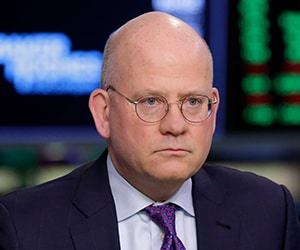GE, once an icon of integration and synergy, is undergoing a massive retrenchment. What does that tell us about the future of conglomerates?

You can pity Jamie Miller for the difficult task she’s been assigned or celebrate the challenge she has taken on. Either way, there’s no denying the enormity of the job before her. Indeed, she might help redefine an entire sector.
Named CFO of General Electric (GE) last October, Miller, 49, has been the right-hand woman—part strategist, part fixer—to CEO John Flannery as the once-iconic conglomerate undergoes a dramatic makeover that will leave it smaller and less complex.
Flannery was abruptly and unexpectedly removed as CEO on October 1 and replaced byLarry Culp who isthe 126-year-old company’s first outsider to hold the position.
Before all is said and done, the company that in recent years boasted a huge financial arm (including a global consumer bank), a television network and aspirations to be what former CEO Jeffrey Immelt called a “top-10 software company” will be centered on just three core businesses: aviation, power plants and renewable energy. “We’ve described 2018 as a reset year,” Flannery told analysts in a July conference call.

Ousted GE CEO John Flannery |
Among the units that have been (or will be) sold, spun-out or significantly shrunk: health care, digital technology, locomotive manufacturing, and oil-services company Baker Hughes, which GE bought 63% of in 2017. GE Capital, once a $600 billion–asset behemoth, now holds $138 billion, with more cuts coming. “It’s about reducing complexity and improving GE’s ability to run its core businesses,” says Eric Ause, a senior director at Fitch Ratings. “GE has been dealing with the complexity of the overall company for quite a while.”
The spectacular implosion of GE’s earnings and share price—the company lost $6 billion in 2017, while its market cap, around $280 billion just two years ago, recently dipped near $100 billion—has sent a shudder through the world of conglomerates, many of which have been struggling themselves. Fair or not, it’s raising questions about the whole business model.
“GE’s meltdown has caused the entire large-cap diversified industrial space to be massively questioned,” says Nicholas Heymann, an analyst with investment bank William Blair. “Most investors today view the multi-industry space as too complex and higher-risk than smaller, more agile global companies.”
The list of multi-industry giants pursuing size-reducing makeovers includes the likes of Honeywell and United Technologies in the US, China’s HNA Group and Anbang Insurance Group and old-line European titans Siemens and ThyssenKrupp. And that’s just a sampling.
About the only place where conglomerates appear secure is Asia, where they are typically younger, family- or entrepreneur-owned, and frequently play the role of “national champion,” promoting a nation’s interests globally and attracting foreign investment. Think Korea’s chaebols.
“A conglomerate in Asia speaks to sustainability. [It’s] like a development board that represents the whole country,” says Terence Yong, who runs the Western Multinational Banking business for DBS Bank in Singapore. “In the West, it’s more market- and investor-driven.”
A need for agility and business synergies—both tougher to achieve with a multi-industry enterprise—and a wave of shareholder activism are driving big companies to think smaller. Conglomerates make ideal targets for funds eager to turn a quick sum-of-the-parts profit in a breakup. “It’s an old-fashioned structure that is getting increasingly difficult to manage” and leaves them ripe for dismantling, Christer Gardell, co-founder of Sweden’s Cevian Capital, told the Financial Times in 2017. Cevian owns stakes in ABB and Ericsson, among others, and is pressuring them to divest businesses. “I think it’s the end of conglomerates,” Gardell predicted. “The major trend in M&A over the next five to seven years will be demergers.”
GE being GE, its recent moves have drawn a lot of attention. But not everyone agrees that they portend the death of the multi-industry model in the West. “What GE is doing is as much about internal mistakes it made coming home to roost as it is an indictment of the conglomerate business model,” says Martin Sankey, a senior research analyst with Neuberger Berman, a mutual fund company that owns about 900,000 GE shares.
The company that started with Thomas Edison’s light bulb has a history of leveraging its global reach by taking on new industries, often via acquisition. Along the way, it grew into one of the world’s most profitable and admired companies. With hindsight, analysts say, it was mostly a mirage—much of it a creation of the finance side of the house. Former CEO Jack Welch was considered a legend, but didn’t pay $10 billion in loss reserves from a reinsurance business GE once owned in order to pump up earnings, leaving Immelt to clean up the mess.
Immelt’s team made things worse with some ill-timed bets that left GE overexposed to an increasingly complex (and risky) web of businesses—a big diagnostic-imaging acquisition in health care, for example, or the $700 million spent annually on building a digital software business—that became too cumbersome to run profitably. “Capital misallocation was the main issue,” Heymann says.
Things came to a head in 2016, when some $34 billion in excess pension obligations and a failed share-buyback strategy helped create a cash-flow crunch that was downright unseemly for a company of GE’s pedigree. In 2017, the year Immelt’s tenure ended, GE’s share price fell more than 40%, even as the S&P 500 rose 24%.
Miller, a former GE controller and CIO, has been part-architect, part-spokesperson for the effort, delivering to investors and the world news both good and bad, including a halving of GE’s dividend right after her appointment. “As we look out the next couple of years, we believe having a healthier … dividend payout ratio is the right thing for the future,” she told investors.
Miller, who was unavailable to comment for this story, benefits from not having been CFO when the bad stuff happened, turnaround experts say. But the demands of being CFO of a large company in turnaround mode are immense—and potentially tricky. Analysts, consultants and investors say that Miller must manage liquidity, asset sales, deleveraging efforts and the company’s response to regulatory investigations (of which there are a few).
Like CFOs in other turnaround situations, Miller must serve several masters, including a board with eight new members eager to straighten things out. It’s common for CFOs in her position to provide the audit committee with regular “reality checks” on the CEO’s plans and strategy.
Simplifying GE is a complicated endeavor itself, and not formulaic. In one illustrative deal, part of the company’s transportation business, including locomotive manufacturing, was sold to Wabtec., while another part was spun out to shareholders and then merged with a Wabtec subsidiary, all to keep the deal tax-free for investors. GE owns 50.1% of the new Wabtec.
Equally daunting, Miller must work within—and presumably try to change—a finance culture with a reputation for “very aggressive accounting practices that caused earnings to be significantly overstated,” Sankey says. In recent decades, GE failed to account properly for liabilities attached to sold assets, including some subprime mortgage loans. Part of what led to the 2016 cash crunch was the build-out of “contract assets”—sales of items like gas turbines, which would be recorded fully in the sales year but be paid over a decade. “It was great for reported earnings, but not great for free cash flow,” Heymann says.
Whether Miller can forge a new culture is open to debate. Sankey notes a recent switch to last-in, first-out accounting from first-in, first out, which he says is counterintuitive at a time when inflation is on the rise—but which can add a couple cents to earnings, suggesting “she hasn’t been able to change that aggressive culture.”
In a fast-paced, grow-or-die corporate world, it’s tempting to agree with the critics who say that GE’s realignment marks the beginning of the end for the clunky conglomerate, but analysts say that would be a mistake. Conglomerates fall in and out of favor on a regular basis and are always adapting to changes in the operating environment. “In a healthy world, a conglomerate should be rejiggering its portfolio in a measured, offensive fashion over time,” Sankey says. “What’s happening at GE is the result of an implosion. It’s a defensive transformation, not offensive.”
That makes Miller’s job challenging, for sure. Whether it is something to be envied will depend on how GE performs going forward.



